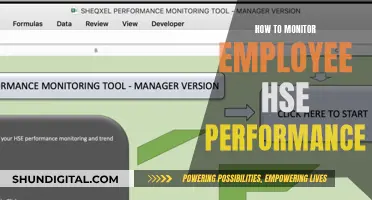
Agribusiness is a complex sector that involves economic activities across the supply chain, from farming and production to marketing and consumption of agricultural products. To ensure the success and sustainability of agribusiness operations, it is crucial to implement effective monitoring and evaluation systems. This process involves defining clear goals and objectives, establishing key performance indicators (KPIs), collecting and analyzing data, evaluating employee performance, and regularly reviewing and updating strategies. By tracking relevant business metrics and KPIs, agribusinesses can assess their progress towards their goals, identify areas for improvement, and make data-driven decisions to enhance their performance and achieve their objectives. This comprehensive approach to performance evaluation helps agribusinesses adapt to changing market conditions, improve productivity, and maintain a competitive edge in the dynamic world of agriculture.
What You'll Learn

Define goals and objectives
To evaluate and monitor agribusiness performance, defining clear goals and objectives is essential. This process involves several key steps, each contributing to the overall success of the evaluation system.
Firstly, it is crucial to establish specific, measurable, achievable, relevant, and time-bound (SMART) goals and objectives. This ensures that the evaluation is tailored to the unique context, resources, and aspirations of the agribusiness in question. For instance, goals could include increasing yield, reducing costs, enhancing product quality, or adhering to environmental standards.
The next step is to identify the key drivers and factors that influence these goals. This involves understanding the various elements that impact the objectives, such as market trends, crop yields, or customer satisfaction. By doing so, the evaluation system can be designed to address these specific factors and their influence on the defined goals.
Subsequently, selecting relevant indicators to measure inputs, outputs, outcomes, and impacts is vital. These indicators should be tailored to the unique needs of the agribusiness and could include financial metrics, production data, or customer satisfaction scores. It is essential to set realistic yet challenging targets for each indicator, ensuring that they are aligned with the defined goals and objectives.
Additionally, it is important to assign roles and responsibilities for collecting, reporting, and reviewing the indicators. This ensures that the evaluation process is systematic and consistent, with clear accountability. Finally, documenting and communicating the defined goals, objectives, and indicators to all relevant parties, including the team and stakeholders, is essential for maintaining transparency and securing buy-in.
By following these steps, agribusinesses can effectively define their goals and objectives, providing a strong foundation for the subsequent evaluation and monitoring process. This process will enable them to align their activities with their vision, mission, and strategy, ultimately driving improved performance.
Cloud Usage Monitor: Understanding Cloud Consumption
You may want to see also

Choose data sources and methods
Choosing the right data sources and methods is critical to evaluating and monitoring agribusiness performance. Here are some steps to help you make the right choices:
Define your goals and objectives:
Start by clearly outlining what you want to achieve, improve, or optimise. For instance, you may aim to increase yield, reduce costs, enhance product quality, or meet environmental standards. This step is crucial as it helps identify the most relevant data points for your specific context and needs.
Identify the required data types:
Depending on your goals, you may need various types of data, such as soil, weather, crop, animal, market, or financial data. Each data type provides unique insights and helps track different aspects of your agribusiness.
Select appropriate data collection methods:
Choose methods that are reliable, accurate, timely, and cost-effective. For instance, you could use sensors, drones, satellites, surveys, or databases. Each method has its advantages and limitations, so consider which ones align best with your objectives and data needs.
Establish data management processes:
Define how you will collect, store, and analyse the data. This includes selecting the right tools and techniques, such as statistical analysis software, databases, or data visualisation tools like charts and graphs. Ensure that your data management system is secure and compliant with any relevant regulations.
Assign roles and responsibilities:
Determine who will be responsible for collecting, managing, analysing, and reporting the data. Involve key stakeholders, such as employees, managers, and data analysts, to ensure a comprehensive understanding of the data and its implications.
Evaluate data quality and validity:
Check your data for errors, gaps, biases, or inconsistencies, and address these issues. Ensure the data is relevant to your goals and reflects the reality of your agribusiness context. This step ensures that your data is trustworthy and can provide accurate insights.
By carefully choosing your data sources and methods, you can make more informed decisions, identify areas for improvement, and optimise your agribusiness performance.
Large Monitor, Large Experience: 42-Inch TV as PC Display
You may want to see also

Evaluate data quality and validity
When evaluating data quality and validity, it is essential to ensure the data is trustworthy, relevant, and aligned with your goals and objectives. Here are some key steps to guide you through this process:
- Identify errors and inconsistencies: Check for any errors, gaps, biases, or inconsistencies in the data. This includes missing data points, inaccurate measurements, or contradictory information across different sources. Correct or discard any data that does not meet the required standards.
- Validate the data: Verify that the data is valid and applicable to your specific context and conditions. Ensure it reflects the reality of your agribusiness operations and aligns with your objectives. For example, if you are collecting data on customer birthdates, ensure the format (e.g., MM/DD/YYYY or DD/MM/YYYY) is consistent and follows your business rules.
- Ensure accuracy: Assess the accuracy of your data by comparing it to verifiable sources or measuring it against established standards. Accurate data ensures that your analysis and decisions are based on reliable information.
- Maintain data integrity: Data integrity is crucial for effective decision-making. It refers to maintaining the consistency, completeness, and security of your data over its lifecycle. Implement measures to protect your data from unauthorized access or alterations, ensuring its integrity and confidentiality.
- Adhere to data quality dimensions: Consider the six data quality dimensions: completeness, accuracy, consistency, validity, uniqueness, and integrity. Strive for data that is comprehensive, accurate, consistent across systems, valid according to specified formats, unique within the database, and maintained with correct attribute relationships.
- Establish data management practices: Implement a robust data management system to store, organise, and secure your data. Define data standards, metadata management practices, and data validation rules to ensure the quality and integrity of your data.
- Utilise appropriate tools and techniques: Employ tools such as statistics, charts, graphs, dashboards, or models to analyse and visualise your data effectively. Identify patterns, trends, correlations, or anomalies within the data to derive meaningful insights.
By following these steps, you can ensure the quality and validity of your data, enabling you to make informed decisions and improve your agribusiness performance.
Monitoring Bandwidth Usage: A Guide for D-Link Routers
You may want to see also

Communicate performance expectations to employees
Communicating performance expectations to employees is a critical aspect of leadership in agribusiness. Here are some detailed and direct instructions on how to effectively communicate performance expectations to your employees in the agribusiness sector:
Understand Your Audience
Firstly, it is essential to know your audience. Understand their needs, preferences, expectations, and values. This includes knowing their level of knowledge, expertise, and communication preferences. For instance, when communicating with farmers, simple and practical language is often more effective, while researchers may prefer more formal and academic language. By understanding your audience, you can tailor your message and delivery to ensure it is clear, relevant, and respectful.
Choose the Right Communication Channels
The choice of communication channels depends on the size, location, and diversity of your team. Consider using multiple channels such as face-to-face meetings, phone calls, emails, newsletters, websites, and social media to increase accessibility and reach a wider audience. For urgent or complex matters, choose real-time channels like phone calls or video conferences. For simple updates or questions, email or text may suffice.
Solidify Your Expectations
When assigning tasks, be clear about the expected standard of work and the timeframe for completion. Avoid ambiguity and ensure employees know what to do if they have issues or questions. Encourage employees to break down larger tasks into steps to improve motivation and commitment.
Hold Regular Meetings
Conduct regular team meetings and one-on-one sessions to keep communication flowing. Set clear goals during these meetings and break them down into individual goals so everyone understands their role and the steps to achieve them. Regular meetings also provide opportunities to restate expectations and keep employees accountable.
Provide Context and Explanation
Help employees understand the importance of their tasks by providing context. Explain how their work contributes to the bigger picture and the positive impact it will have on the organization. This will increase their motivation and willingness to follow instructions.
Keep it Simple and Direct
Simplify your message to ensure employees don't miss important information. Long conversations may lead to disinterest and misunderstandings. Be direct and use simple language to ensure your instructions are clear.
Be Consistent and Transparent
Consistency and transparency are crucial in building trust and credibility with your employees. Ensure your message is consistent across all channels and aligns with your agribusiness values, vision, and goals. Avoid ambiguity and jargon, and be honest and transparent in your communication.
Seek Feedback and Make Adjustments
Regularly seek feedback from your employees to evaluate and improve your communication strategies. Show appreciation for their input and be open to making adjustments based on their suggestions. This will help build stronger relationships with your employees and improve their satisfaction.
Meet with Employees Regularly
Hold frequent one-on-one and team meetings to clarify expectations and address any concerns. Recognize and reward employees who excel, and provide private meetings for those who need additional support to meet their goals. Be accessible and encourage employees to come to you with questions or for assistance.
Provide Helpful Resources
Make resources readily available to assist employees in completing their tasks. A company handbook or style guide can outline job responsibilities and company rules. Provide website links or other materials to facilitate task completion.
Check in with Employees Regularly
Hold follow-up meetings to understand employees' progress and provide support. Keep these meetings short to show trust and care. Checking in early and often can help avoid errors and ensure employees remain on track.
Use Positive Language
Politeness, respect, and constructiveness are key. Avoid negative words or tones that may convey criticism or anger. Instead, use positive language to create a positive atmosphere, motivate your team, and resolve conflicts constructively.
Provide Feedback
Give and receive feedback regularly and respectfully. Feedback helps evaluate performance, identify strengths and weaknesses, and improve skills. It also demonstrates recognition and appreciation for your team's efforts and contributions.
Be Calm and Composed
When communicating expectations, it is important to remain calm and composed. Remove emotions from the conversation to maintain neutrality and effectively convey your message.
By following these instructions, you can effectively communicate performance expectations to your employees in the agribusiness sector, leading to improved engagement, productivity, and overall success.
Setting Up Studio Monitors: Interface Connection Guide
You may want to see also

Employee development
Understanding the Need for Employee Development
Firstly, it is important to acknowledge that employees in the agricultural sector are often aware of the need to learn and develop their skills. This awareness presents a unique opportunity for agribusiness companies to encourage and facilitate their employees' engagement in development processes. However, it is also essential to consider the organisational features that influence employee development.
Strategies for Employee Development
Performance Appraisal and Goal-Setting
Performance appraisal is a critical tool for employee development. It involves evaluating an employee's job performance against the requirements of their role. This process should be fair and transparent, with clear communication of performance expectations and feedback to ensure employees understand their strengths and areas for improvement. Setting SMART goals (Specific, Measurable, Achievable, Relevant, and Time-bound) can help provide direction and motivation for employees to develop their skills and knowledge.
Training and Development Programmes
Agribusiness companies should invest in comprehensive training and development programmes to ensure employees have the necessary skills and knowledge to perform their jobs effectively. This includes initial training when employees transition into new roles and ongoing development opportunities such as workshops, conferences, and coaching systems. Such initiatives foster a culture of loyalty and respect, reduce employee turnover, and increase engagement.
Internal Promotions and Career Advancement
Offering internal promotions and creating a culture of career advancement can be a powerful incentive for employees to improve their performance. Employees who see opportunities for growth and development within the organisation are more likely to be motivated and committed to enhancing their skills.
Flexible Work Arrangements
Agribusiness companies can also promote employee development by offering flexible work schedules and telecommuting options. This demonstrates trust in employees and can lead to increased productivity, as employees can better manage their time and energy levels without the constraints of a traditional work schedule.
Feedback and Performance Metrics
Regular feedback and performance metric analysis are essential for employee development. Managers should provide clear and actionable feedback to employees, highlighting areas of excellence and areas that need improvement. Additionally, analysing performance metrics can help identify gaps in organisational workflow and inform the development of support systems for employees.
Collaboration and Teamwork
Creating opportunities for collaboration among employees can enhance individual performance and build trust. Collaboration allows employees to learn from each other, foster innovative solutions, and improve overall team morale.
Well-being and Support
Building a culture that prioritises employee well-being and support is crucial for employee development. This includes offering competitive salaries, comprehensive benefits packages, workplace perks, and a healthy work environment. When employees feel valued and supported, they are more likely to perform at their best.
Benefits of Employee Development
- Increased employee commitment and loyalty
- Improved employee performance and productivity
- Enhanced employee satisfaction and reduced turnover
- Development of a skilled and knowledgeable workforce
- Improved ability to adapt to changes and innovations in the industry
Connecting Cable Box to Multiple Monitors: Easy Steps
You may want to see also
Frequently asked questions
Important data points include production data (yield, quality, input costs, time to market), government/policy data (export incentives, subsidies, import substitution), and financial data (historical price points, profitability, opportunity cost).
KPIs are specific and quantifiable metrics that help track and evaluate the progress of your agribusiness operations. They can be used to identify strengths and weaknesses, benchmark performance against competitors, and make data-driven decisions to improve performance.
The steps include defining the purpose and scope, establishing governance and coordination, designing data collection and analysis processes, developing reporting and dissemination strategies, implementing the system, and regularly reviewing and updating it.







